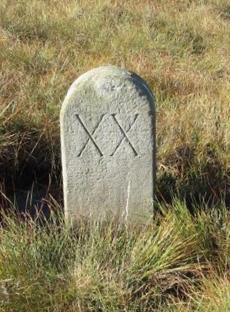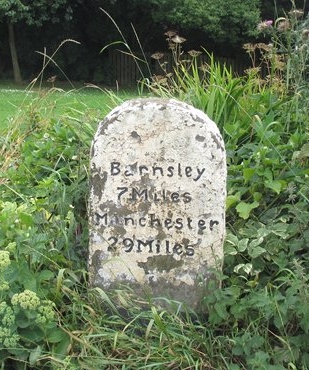Milestones on an old saltway to South Yorkshire

Salt had many uses in mediaeval times (and earlier) but was most valuable as a food preservative. The main source of salt for inland areas of the north was Cheshire – the so-called “Cheshire wiches” of Middlewich, Nantwich and Northwich. The saltways along which this vital commodity was carried can be traced in many street and area names still found today: Salters Ford, Saltergate, Salter Hill, etc. Even Psalters Lane in Rotherham is derived from the salt route rather than any monastic connection.
One route entered the West Riding (South Yorkshire) via Stockport and the Longdendale Valley at the appropriately-named Salter’s Brook Bridge, the boundary between Yorkshire and Cheshire (though now Derbyshire), near Woodhead. This road was turnpiked by the Doncaster and Salter’s Brook Trust in 1740, connecting with the slightly earlier Manchester and Salter’s Brook Turnpike. In 1828, in the second wave of “turnpike mania” this route was replaced by a new one, easing the gradients, and running sometimes north, sometimes south of the old saltway. This road is the present A628, but the old route between Woodhead and the now demolished Flouch Inn can be easily traced on an Ordnance Survey map. A  mile or so beyond the Flouch the turnpike continued past Barnsley to Doncaster, while another branch of the old saltway headed right for Rotherham.
mile or so beyond the Flouch the turnpike continued past Barnsley to Doncaster, while another branch of the old saltway headed right for Rotherham.
Many old milestones survive on both routes: the new road was never provided with the Brayshaw and Booth stones set up shortly after the County Council took over responsibility for highways in the 1890s. The milestones on the old route are especially interesting. Starting just over the boundary in Cheshire one can be found built into a wall overlooking Woodhead Reservoir (grid ref SE 1055 0005): this gives the miles to Manchester (19) – top picture. The next milestone, the last in Cheshire/Derbyshire, is missing.
Many of those on the Yorkshire side, however, survive, and have been traced by David Hey. These quote the number of miles to Rotherham, which are given in Roman numerals – though the actual destination is not usually named. The first, very close to the county boundary, is badly eroded, but reads “Wortley XII Miles Rotherham XXI Miles”. The next, 20 (XX) miles to Rotherham, the second picture (right) is at SE 1550 0005, south of the A628 at Fiddlers Green.
The picture at the bottom shows the later Doncaster turnpike milestone on a disused stretch of the A628 just west of the Flouch (as was).
The Rotherham branch was turnpiked at the same time as the Doncaster road – hence the milestones – but was not financially successful, particularly after the construction of the Halifax to Sheffield Turnpike (the present A629) in 1777 and today remains as a number of apparently unconnected mino r roads.
r roads.
There are a number of other interesting features on the old road, including some Manchester Corporation Waterworks boundary stones, and the mediaeval Lady Cross. This marks the eastern boundary of the manor of Glossop, but would also have served as a route marker. The Lady Cross, the Rotherham 21 milestone, and a number of other stones in the region are marked with the letters IWB – some graffiti by Isaac Watt Boulton. Boulton (1823-1899), an engineer and industrialist from Ashton (and related to the famous Matthew Boulton of Birmingham) was a keen rambler and campaigned for public access to ancient paths in the Peak District.
Sources: David Hey: talk to the Milestone Society AGM, 2007, and his Packmen, carriers and packhorse roads, 2nd ed (Landmark Pub, 2004); Stocksbridge and District History Society website, and an article by W E Spencer in their newsletter, Paragon, no 12, summer 1998, also available online; Fell Runners Association forum; Grace’s Guide to British Industrial History.
RWH/rev June 2020
Milestones on an old saltway to South Yorkshire Read More »
